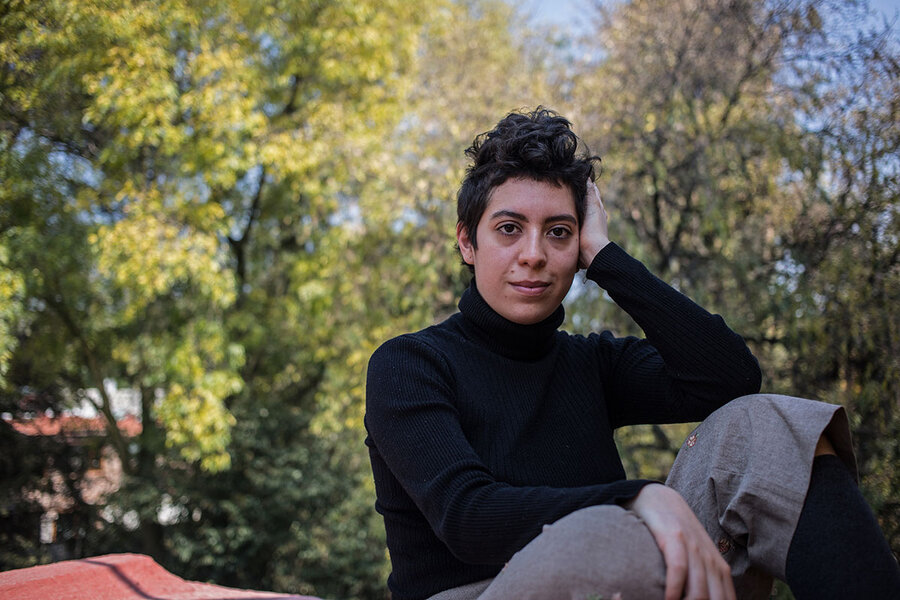Creativity and guilt: Artist Jimena Pérez Sánchez on having COVID-19
Loading...
| Mexico City
It felt like Disneyland or something: Walking to that first spin class after eight months of lockdown, I was really excited, really happy. Here I was with my next-door neighbor, Valeria, who has become a close friend during the pandemic. And then a new spinning place was opening up around the corner from my quiet block. We could walk from our town houses to take classes together every week.
I got on a bike in the way back of the room. There was a lot of distance between people, all panting and sweating through their masks, but the instructor wasn’t wearing a mask. I took mine off for a second to wipe my face, and at another point to quickly catch my breath.
I felt happy and really kind of free for the first time in months. My focus was on pedaling and following the rhythm of the teacher. After class they gave us free smoothies, and Valeria and I sat outside chatting through our masks for a while. It was such a release; like, how did I get so fortunate?
Why We Wrote This
Strict about COVID-19 protocols, this Mexican student got sick anyway. How she dealt with guilt and parlayed the experience into a creative burst is one of 12 intimate stories in the Monitor’s interactive 21 in ’21 global report about how the pandemic affects a generation on the cusp of adulthood.
That was on a Thursday; I started feeling lousy on Monday. In the first few days I said to my parents, what if this is COVID? We’ve had to take care of ourselves even more than most families because my mom is at high risk. We avoid going out at all costs. I haven’t seen friends face-to-face other than Valeria since this all started. I was convinced the studio was safe – I wouldn’t have gone to the class otherwise.
The fact that both my parents said, “Take it easy. You’re fine!” reassured me. My mom was so calm, and normally it’s she who feels when something is wrong. So, I said, “OK, she’s probably right. I won’t worry anymore.”
When I lost my sense of taste and smell, I knew.
My mom found the testing site. Two days before our appointment we were already taking safety measures: each sleeping in a different room, using gloves in common areas, cleaning door handles, wearing masks. Riding to the testing site, I wasn’t tormenting myself; I figured we’d see what happens.
When the test results came back, my mom told me through my closed bedroom door, “You and I are positive.” I was frozen: I already basically knew I had it. But that my mom had it, too, really hit me. She’s fragile. Knowing I probably gave it to her was overwhelming.
At first, I threw myself into my college work – an assignment with acrylic paints, watercolors, and ink. I placed the canvas on my studio table and moved around in circles, painting from different perspectives. I used darker colors and more intense brushstrokes than normal. It helped me to distance myself and it gave me a sense of control and purpose.
By the second week, I couldn’t even read I was so exhausted. I felt frustrated: Did I get my mom sick? I felt helpless: I couldn’t hug her or my dad. I felt alone, stuck in this same space day and night.
My mom checked into the hospital on a Monday. Right before she left the house, we opened the doors to our rooms and talked. She said, “Jimen, I’m afraid.” And I said, “Me too.”
I couldn’t go with her to the hospital. I couldn’t hug her goodbye. She told me she was leaving for days, not weeks – but I couldn’t kick the fear and sadness. I felt utterly terrible. If I hadn’t gone to that stupid spinning class, my mom never would have gotten sick. My therapist says “would have” doesn’t exist. I can’t change the past. That helped me.
I cried a lot. But I sang, too.
Something that helps me when I feel awful is to do vocal exercises, in my room, standing in front of the mirror. There are lots of technical rules about your posture and how your diaphragm moves. But when I start singing, I feel parts of my body I don’t notice any other time. My voice vibrates inside my head, and it becomes this sounding box just humming and it’s like a meditation. I did it for almost an hour right after my mom left, and it helped me find a release from this guilt and all the emotions I was feeling. Catharsis.
My dad and I started living in common areas together soon after my mom went to the hospital. One night I asked him if he was mad at me. Because of my mom. He said there was a moment when he felt angry with me.
But, he said, “Look, you’re my daughter and I love you. I’m not going to let that anger change our relationship. Besides, what if I was asymptomatic? What if I was the one who got you sick?” He’s the one who does the grocery shopping and runs our errands. Anything’s possible.
I’m staying home now. It doesn’t scare me, this idea of not leaving the house. I still have my online classes, I still have my books. I have the internet. No more weekend movies with Valeria. Definitely won’t be going back to spinning.
But, my mom is going to be OK.
Read other personal essays like Jimena’s from 21-year-olds in our 21 in ’21 global report about a generation coming of age in the pandemic.






